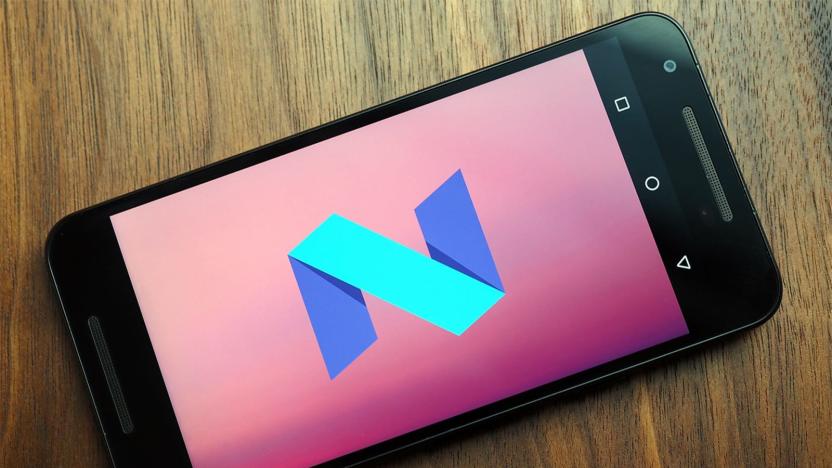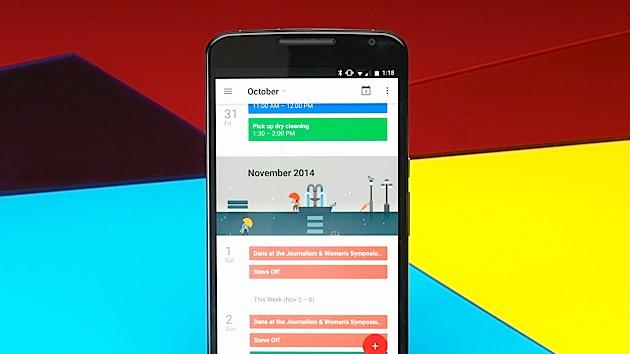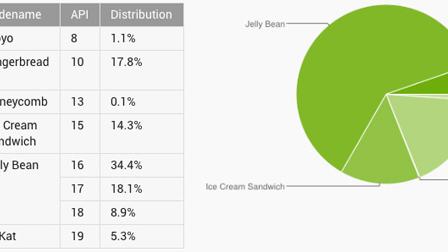androidversions
Latest

Nougat is now the most-used version of Android, 17 months later
Google hasn't quite licked its problems getting users to adopt the latest version of Android. Its latest Play Store user share stats show that Nougat has become the most-used Android release at 28.5 percent... just over 17 months after its summer 2016 debut. Not exactly a speedy transition, then. That still gives it the edge over the older-still Marshmallow release, mind you, and indicates that a large chunk of the user base is running a modern take on Android.

Marshmallow is now on 10 percent of Android devices
The latest version of Android just hit a big, big milestone. Google's early June developer stats have revealed that Marshmallow is now on just over 10 percent of Android devices, representing a huge jump from just 2.3 percent in March. Notably, only some of that surge can be credited to people upgrading from Lollipop. While the not-quite-current version's adoption did go down (to 35.4 percent), the biggest declines in usage were for Jelly Bean and KitKat. In essence: many of those moving to Marshmallow may well have been replacing devices that were 3 or more years old.

Lollipop becomes the most popular version of Android
At last, there's a new flavor of Android on top of the heap. Google has published updated stats which show that Lollipop is now the most-used version of Android, snagging 36.1 percent of device share in early March versus former champ KitKat's 34.3 percent. It's a big milestone that suggests many Android users are using a reasonably modern take on the mobile platform.

Nearly a quarter of Android users are running Lollipop
Android Lollipop is enjoying its last, shining moment in the sun before Marshmallow arrives in earnest. Google's not-quite-current operating system now accounts for 23.5 percent of active Android users, a healthy 2.5-point boost from what you saw just one month ago. That's still trailing behind Jelly Bean (30.2 percent) and KitKat (38.9 percent), but it's clear that all those new devices and upgrades are starting to add up. The real question is whether or not that momentum will last. Marshmallow is arriving relatively quickly, and shouldn't suffer from the early performance and battery life woes that kept some people from upgrading last year. If the newer release catches on quickly, Lollipop might not reach the lofty adoption rates of its predecessors.

Android Lollipop is slowly (very slowly) hitting more devices
Lollipop didn't exactly take the Android world by storm when it first launched. Early adoption was slow enough that it made no real impact in usage share stats for the first couple of months. People are starting to take to Google's latest dessert-flavored OS, however -- it's finally on the official radar. Google's data now shows that about 1.6 percent of active Android users were using Lollipop as of the start of February. That's certainly not a lot, but it's clear that all those Nexuses and early Lollipop upgrades (most notably from HTC, LG and Motorola) count for something.

Lollipop isn't making a dent in Android usage numbers (yet)
Now that Android 5.0 Lollipop is finally rolling out to devices around the globe, you might be wondering just how much of an impact it's making on the Android ecosystem. The short answer: not much. Google has released its latest Android usage stats, and Lollipop doesn't even register yet -- in other words, less than 0.1 percent of Google Play users have moved to the new software. That's not surprising given that both the upgrade and Lollipop-native devices like the Nexus 6 are weeks old at best, but it suggests that the new OS will take a while before it makes its presence known.

KitKat is now running on more than 20 percent of Android devices
In case there was any doubt that KitKat now has a solid foothold in the Android world, Google just offered some proof. Its usage data for early August shows that KitKat is on more than a fifth of active Android devices, at 20.9 percent. That's a healthy improvement over July (17.9 percent), and a big leap over the 14.9 percent we saw in June. The folks in Mountain View aren't explaining the steady growth, but it's easy to figure out what's going on -- big-name devices like the LG G3 and Samsung Galaxy Tab S are bringing this latest OS flavor to a wider audience, and many older gadgets are still getting upgrades.

KitKat is now on nearly 14 percent of Android devices
You know how Apple was keen to point out that only 9 percent of Android users (technically, 8.5 percent) were running KitKat in May? Well, that figure's now out of date. Google has published fresh usage stats which show that 13.6 percent of Android owners are using KitKat as of early June. That's still far from a majority, but it represents a 60 percent jump in a single month. It's not hard to see why the newer OS would be making such big strides. Major new phones like the HTC One and Galaxy S5 have had more time on the market, and KitKat upgrades are still making their way to older gadgets.

KitKat's share of Android devices more than doubles to 5.3 percent
After months of treading water, Android 4.4 KitKat is finally taking off. Google reports that 5.3 percent of Android users are running the newer OS version as of early April; that's more than twice the 2.5 percent that it claimed one month earlier. There's no official explanation for the jump, but it's most likely thanks to a wave of KitKat upgrades from HTC, LG and Samsung. Most older versions lost share as a result. It could be a long, long time before KitKat overtakes Jelly Bean (which dipped to 61.4 percent), but the transition is under way -- and it's only likely to accelerate now that flagships like the Galaxy S5 and new One are reaching store shelves.

More than half of Android devices now run Jelly Bean
It may have taken almost a year and a half, but Google can at last say that the absolute majority of active Android devices are using some form of Jelly Bean. The company's OS dashboard shows that 52.1 percent of owners are running at least Android 4.1; most of those (37.3 percent of the total) rely on the oldest version, but Android 4.2's use has already doubled since August. Jelly Bean's reign may be short-lived, however. The milestone comes just as Android 4.4 KitKat is reaching the public -- given Google's focus on supporting as many devices as possible with the new OS, it may not be long before Jelly Bean is once again in the minority.

More than 40 percent of active Android devices now run Jelly Bean, Gingerbread stubbornly holds steady
The last time Google visited Jelly Bean's user saturation numbers, it took the combined efforts of 4.1 and 4.2 to edge out Gingerbread's (v2.3.3 through 2.3.7) hold on the user base. Not anymore; the latest numbers from the Android Dashboard show the base version of Jelly Bean, Android 4.1, representing 34 percent of the active devices -- singlehandedly surpassing the old guard's 33 percent share of the market. When combined with the rest of the Jelly Bean contingent (Android 4.2 and above), Google's latest flavor of Android crushes Gingerbread with a 40.5 percent majority. Froyo (v2.2), Eclair (v2.1) and Ice Cream Sandwich (v4.0.3 through 4.0.4) all took modest hits as well, though the latter of the trio retained its third-place position with 22.5 percent of active users. The only builds to hold steady? Honeycomb (v3.2) and Donut (v1.6), each retaining a miniscule 0.1 percent of the market. We'll admit, it's cute to see these old versions hang on, but please -- if you're still rocking a handset running Android 1.6, do us all a favor and turn it off.

Android's Jelly Bean contingent finally surpasses Gingerbread
It's a new era, we tell ya. An era where Google can finally say that its latest build of Android is also the one being used by the greatest majority of Android users. For over a year, Android 4.1+ has been the most up-to-date build of Google's mobile OS, and yet, the greatest majority of those accessing the Play Store were using a build that was bordering on antediluvian. According to the official Developers Dashboard, the percentages have slid to a point where Android Jelly Bean -- which encompasses 4.1.x and 4.2.x -- now represents 37.9 percent of Play Store users. Gingerbread (v2.3.3 through 2.3.7) has fallen to second place with 34.1 percent, while Ice Cream Sandwich (4.0.3 through 4.0.4) holds down the bronze with 23.3 percent. Hit up the source link to view the full breakdown, and do us a solid -- if you know someone still using Donut, grab 'em a Christmas-in-July present.

Jelly Bean now on 33 percent of active Android devices, Gingerbread still leads
Google's pushed out its latest survey of the Android landscape, and Jelly Bean is finally creeping up on Gingerbread for the crown. While Gingerbread accounts for 36.5 percent of active devices sporting Mountain View's OS, versions 4.1 and 4.2 stand just behind with a total of 33 percent, up 4.6 percent since last month. Ice Cream Sandwich is helping itself to 25.6 percent of the statistic pie, while Froyo, Eclair and Donut each trail behind with less than five percent combined. Now that Jelly Bean is within a 3.5 percent striking distance of the top spot, this may be the last time we see Gingerbread in the lead.

Android metrics show Jelly Bean adoption overtaking Ice Cream Sandwich
Google's big shake-up of Android version metrics has already given us a better understanding of where the platform's active users truly stand. Now that we're a month into the new methodology, we have a good sense of where those users are going -- and they're moving to Jelly Bean in droves. Android 4.1 and 4.2 combined grew to represent 28.4 percent of regular usage, or enough to finally overtake Ice Cream Sandwich at 27.5 percent. Not surprisingly, the transition to the newer OS involved a balanced mix of users either upgrading from ICS (down by 1.8 percent) or transitioning from devices running Gingerbread or earlier (down 1.7 percent). It will be a long while before Jelly Bean becomes the dominant platform, if it ever does, but we're not expecting a slowdown in adoption when flagships like the Galaxy S 4 and One are luring many of us into an upgrade.

Google changes Android dashboard numbers to count active users, not just pings
The Android device dashboard has been providing a picture of OS version distribution since before Froyo pushed aside Eclair, but now it's seeing some changes. A post on the Android Developers Google+ page indicates that starting this month, numbers are based on devices whose users actively checked Google Play during the reporting period. Previously, it counted all devices that pinged Google servers. The latest stats, updated today, show a jump in the amount of actives (previously devices, now users) on Jelly Bean (Android 4.1 or higher), up to 25 percent from 16.5 percent last month when it counted the old way. The number of devices recorded running Froyo and Gingerbread have taken the biggest hit, down 3.6 and 4 percentage points, respectively. There are a few ways to react to this, particularly remembering that these numbers are meant to help developers figure out how many users are available to target on the various versions of Android and types of hardware. It may help give a clearer picture of what setups the active users that developers hope to reach are using, without being muddied by little-used zombie hardware. On the other hand, it could be seen as a way to juke stats which have been used against Google's mobile OS by its competitors like Apple. Whichever side of the line one finds themselves on, more data is available by clicking on the source link below.




